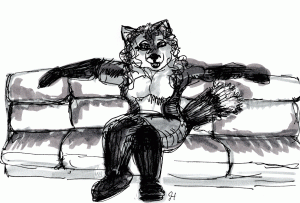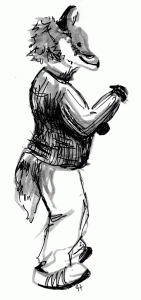(And other questions for Furries)
By Keith Hadad
Imagine you are on a hot date with someone you’ve been admiring for quite a while. After the dinner, the excited dancing, the moonlit drive home, they invite you up into their room. “I usually don’t even kiss on a first date,” you may think, but you go along anyway.
Once you’re sitting on the couch, maybe with a drink, they deliver cliché lines like, “I’ll go slip into something more comfortable.” You lean back while they disappear into the bedroom, and images of lingerie or silk boxers form in your mind. “I’m ready…” you hear slyly from the room.
Then the door swings open and instead of a desirable body, there’s a life-sized fox mascot staring at you with its arms open wide.
Yes, this actually happens to people the world over. There are people who get their kicks from dressing in modified animal mascot-like costumes and having fuzzy, overheated sex. This is known as “yiffing,” and it’s practiced by what are known as “Furries.”
Furries are best described as members of “The Furry Fandom.” According to a blogger of claws-and-paws.com who writes frequently about the Furry phenomenon, the FF is “the appreciation, promotion and production of stories and art about anthropomorphic animals [animals with human characteristics], as well as the exploration, interpretation and examination of humanity and human values through anthropomorphic expression.” This definition is possibly the friendliest from online sources, since the online community often criticizes the fandom as being over-the-top, disturbing and downright criminal.
One reason the fandom causes confusion and even anger is because Furries claim to be based on anthropomorphic animal characters in the media, mainly children’s shows or movies. The appreciation of these characters is often turned sexual, literally “raping” the personalities that many people watched in their childhood through comics, art, stories and cartoons. Not all Furries dress up to perform sexual acts, though. Most simply enjoy the FF for its roots in expressing their interest in anthropomorphic animals.
In his book Furry! The Best Anthropomorphic Fiction!, Fred Patten, a fandom historian details the origins of Furries. When anthropomorphic characters starting popping up in fiction novels, including 1972’s Water Ship Down by Richard Adams, Steve Gallacci took an interest in the animals. In 1983, he incorporated similar creatures into his comic series called Albedo Anthropomorphics. At comics and science fiction conventions, a cult following began to envelope Gallacci’s comics, and today, his work is considered the first spark to set off an official, organized Furry Fandom.
Furries & Avians & Scalies, oh my!
“Most Furries respect their boundaries,” says Chris, an ex-Furry who once was deeply immersed in the subculture. “They are pretty much normal people and may very well have loose connections to the fandom.”
Generally, the typical member of the Furry Fandom will dress as a human-sized mammal, often in hand-made suits, and will adopt cartoon-like mannerisms. Most would only dress up among other Furries, inside their own homes, at conventions or any other similar gathering, so it’s likely you will never run into these costumed conundrums in everyday life. If there isn’t a convention in town and you’re not already one of them, it’s not easy to recognize the Furry in someone. In a 2003 Tri-Valley Herald article, Lee Strom, then-chairman of Further Confusion, one of the largest Furry conventions, said the convention draws mostly men in their 20s and 30s, though they often see families, doctors and women attend, too.
There are many kinds of Furries, though. Some take up personas based on birds (considered Avians or Featheries), dragons or other reptilian creatures (known as Scalies) and even centaurs (unimaginatively known as Taurs). And the behavior of Furries may vary depending on the creature or the individual.
“‘Lifestylers,’ people who shape their lives around the fandom, on the other hand, may incorporate barking or any other animal sound into everyday speech,” says Chris. The most popular of these sounds are “Murr” and “Meef.” “Some may even wear their artificial tails or ears in public. Mainly, they are seeking attention or intending to create a reaction, positive or negative,” he says.
Of course, there are various forms, subgenres and subcultures of the fandom. Some self-proclaimed Furries claim to be innocent, only dressing up as a mascot and mime for the amusement of others. Still, some assert that they are actually animals trapped inside human bodies, and they despise humans and all things related to humanity. Between these two kinds of Furries, many diverse subgroups are largely based on sexual fetishes.
Following the Furnomenon?
Apart from being depicted in a few mainstream TV shows, such as The Drew Carey Show or a highly popular episode of CSI: Crime Scene Investigation, mass media hasn’t touched on the phenomenon, but the FF has an ever-growing following. Furries now have the opportunity to attend over 11 annual conventions throughout the U.S.
Further Confusion (FurCon), a San Fransisco Bay area convention that focuses on charity and education, to be held in San José next year, draws over 2,400 Furries each year. It is one of the largest international conventions celebrating the FF. Its participants include people of all ages, and it features guests, educational panels, artwork, collectibles, an art show benefiting charitable organizations, gaming and nightly dances. FurCon is in its twelfth year, and according to its Web site, it’s becoming larger and more popular each year.
Online, Furries can also chat and communicate with people from around the world who share their love. “The Internet seemed to bring the once-small group to be seen by anyone all over the world,” says Chris. “Once this happened, people observed what others had been doing, they felt a connection with the fandom that they were exposed to, they felt a belonging, and were able to explore it more.”
Underneath the Fur.
“[Some] see [the FF] as how it started…as a simple fandom,” says Chris, purely from experience, citing Trekkies or otaku anime fans as other examples of fan groups. So far, there aren’t any studies published on this subject, so most of what is known about Furries comes from those who have experienced it themselves.
“How the obsession starts… is usually a certain affinity with anthropomorphic characters you see as a child from TV shows, movies or books, and your nostalgia blooms into a strong appreciation of those characters and the innocence of that period in your life. It is also used heavily as an escape from the pressures of adulthood.”
“The definition of ‘furry as a way of life’ is more accurate [sometimes],” explains an anonymous Furry on Wikifur.com. “For these furs, furriness is not something that you do; it is something that you are, an inseparable part of oneself. It may be a part of their spirituality. This is distinct from the notion of being a furry fan, who, by contrast, can choose to ‘not be furry’ at times.”
Furriness can become a spiritual inclination to some. “Some people look at it like a religion due to the need to belong and welcoming acceptance,” Chris says. It’s easy to see that an explanation for why Furries do those furry things that they do is mainly situational and hardly easy to pinpoint. Some say it would be crazy to do anything inside of a hot sweaty costume, but others just find it to be crazy to be going around town without one. Yet no matter how deep a discussion about Furries can get, one question always arises: Doesn’t it get hot in those costumes, especially when you’re having sex, or yiffing?
The answer is enough to deter most from participating in any sort of Furry fun. “Unfortunately, it can get bad inside, especially if you don’t have good ventilation inside the suits,” says Chris. “That’s why many suits are built with small fans inside of them, or every Furry and mascot would die of heat exhaustion.” So, if you find yourself yearning to enter the Furry subculture but want to avoid an awkward death, please do yourself a favor and invest in an easy-to-install fan system.
____________________________________
Keith Hadad is a freshman cinema and photography major, and if he had an anthropomorphic alter ego, it’d be a panda bear. But he doesn’t, so kindly stop asking. E-mail him at khadad1@ithaca.edu.
This article has been modified since publication in the November 2009 issue of Buzzsaw. After publication, it was brought to the editors’ attention that one paragraph in this article (about the origins of the FF) was reworded from Wikipedia but not attributed to a legitimate source. This was the only instance where it occured, unintentionally, and we have now edited the paragraph. Buzzsaw apologizes to it readers for this mistake.


